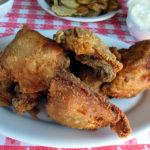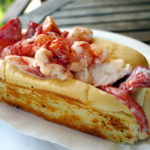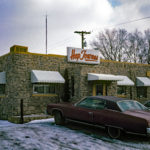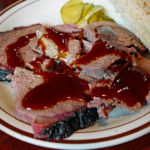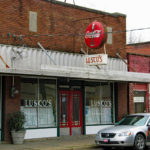Yankee Top Dogs
Hot dogs, the most American food of all, defy the regimentation that has made hamburgers, prime steaks, pancakes, and pizza such conspicuously successful franchise opportunities. (There are more than 23,000 McDonald's around the world; Nathan's Famous, the country's only major hotdog chain, has fewer than two hundred outlets.) The wiener has remained a free agent because its gastronomics are so doggedly parochial. Who among us doesn't have their own personal idea of precisely what a good hot dog should be made from (beef, pork, veal, or a combination thereof) and how it should be cooked (boiled, grilled over coals, or fried on a griddle), let alone such crucial issues as proper bun preparation (steamed soft or toasted crisp) and correct dressings (sauerkraut, chili, cheese, bacon, mustard, relish, ketchup, raw onions, grilled onions, tomatoes, salsa, pickles, celery salt, hot sauce, or hot peppers)?
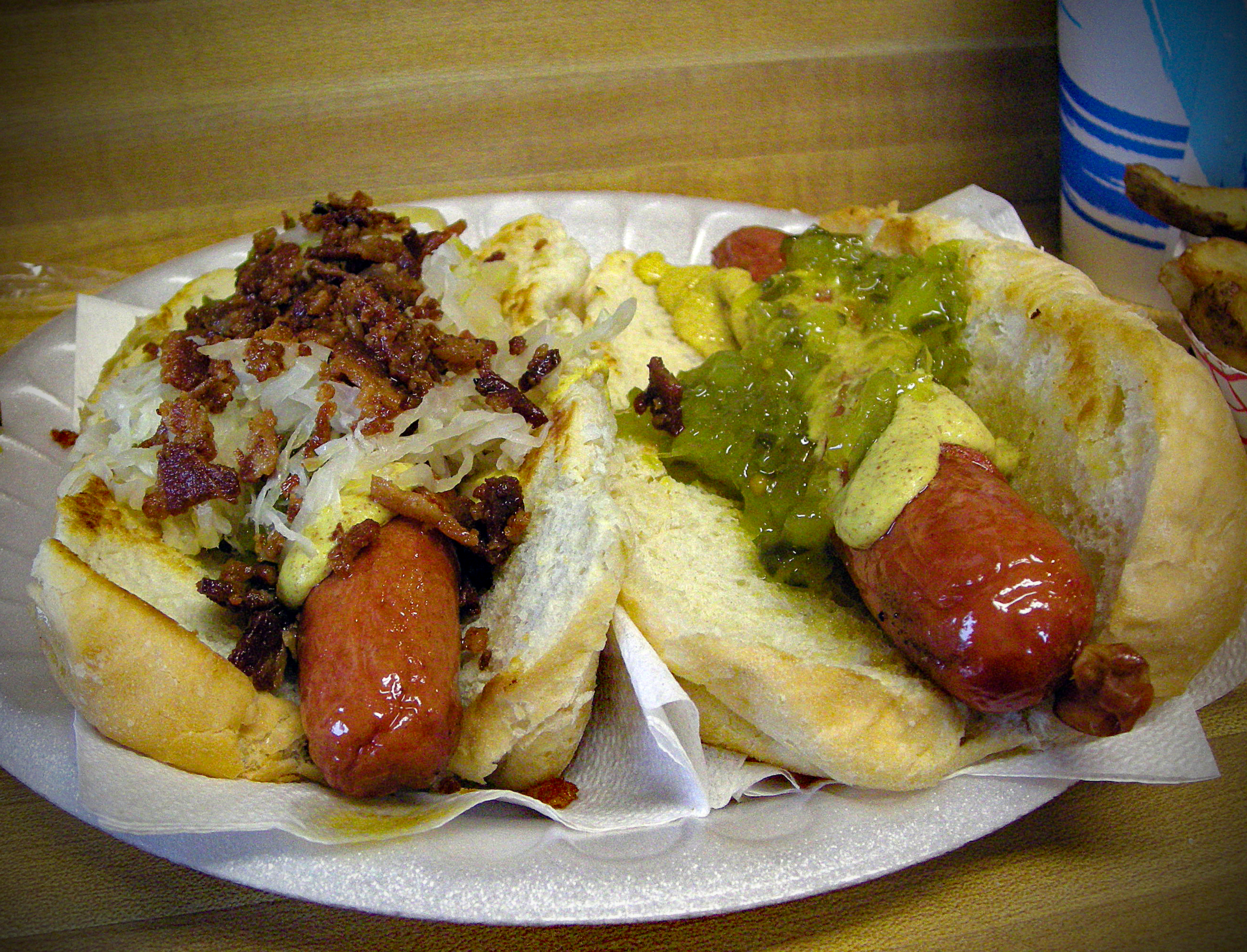
By Jane and Michael Stern
Originally Published 1999 Gourmet Magazine
Hot dogs, the most American food of all, defy the regimentation that has made hamburgers, prime steaks, pancakes, and pizza such conspicuously successful franchise opportunities. (There are more than 23,000 McDonald’s around the world; Nathan’s Famous, the country’s only major hotdog chain, has fewer than two hundred outlets.) The wiener has remained a free agent because its gastronomics are so doggedly parochial. Who among us doesn’t have their own personal idea of precisely what a good hot dog should be made from (beef, pork, veal, or a combination thereof) and how it should be cooked (boiled, grilled over coals, or fried on a griddle), let alone such crucial issues as proper bun preparation (steamed soft or toasted crisp) and correct dressings (sauerkraut, chili, cheese, bacon, mustard, relish, ketchup, raw onions, grilled onions, tomatoes, salsa, pickles, celery salt, hot sauce, or hot peppers)?
Regional loyalty plays a big role in the hot dog’s enduring independence. A person’s frankfurter of origin is as much a cause of allegiance as a home team or an alma mater. For anyone who grew up eating split-and-grilled tube steaks in Connecticut’s Savin Rock; charcoal-grilled “white hots” in upstate New York; “slaw dogs” at The Varsity, in Atlanta; or chili dogs at Pink’s, in Los Angeles, it is not likely any other style of sausage could equal the savor of those memories. The two of us have our own chauvinistic prejudices, having grown up on Coney Island all-beef beauties (Jane) and Chicago “Vienna Red Hots” in poppy-seed buns (Michael). But, after decades of diligently sampling franks of diverse derivation and configuration, we are here to suggest that the hot dogs of coastal New England, from Connecticut to Maine, set especially high standards of excellence.
There is no one kind of link unique to the region, and among the following quartet of recommended places each has its own distinct personality and its own style of hot dog. Of course, all four do share certain fundamentals, such as low price and casual ambiance (a swanky frank is a self-contradiction), and every one of them is guaranteed to deliver the kind of devil-may-care satisfaction that makes weenie-eating especially right on a pleasure-seeking summer day.
“A hundred percent meat and piping hot!” is the prescription for goodness offered by RAWLEY’S DRIVE-IN, of Fair-field, Connecticut. One-time owner Bob Rawley, who retired after selling the restaurant to current chef and proprietor Chico Bielik in 1971, says that when he bought the red-painted wood-frame house on Route 1 in 1954 (and gave it the name that has endured for more than four decades), a fellow named Bill Lorenzo was operating a thriving hotdog business there. Before Lorenzo, there was a vendor now remembered only as “The Southerner,” who lived in the house and sold hot dogs from a cart in the lot just outside. Local patrons who started coming during The Southerner’s regime in the 1940s say that little has changed in the last half-century, other than the fact that Chico added chili to the repertoire of available toppings and the wooden walls and ceiling have grown ever more colorful with the names and initials of generations of customers carved in every free space.
Rawley’s is pint size: four booths plus a six-stool counter on what used to be a front porch, where an open picture window provides a scenic view into the lively short-order kitchen. Adjacent to the counter is a pay phone that rings often during the lunch hour as hopefuls try to place an order. We say “try,” because when Rawley’s is crowded, as it always is shortly after noon, the staff of four have their hands full taking care of dine-in and take-out business and they simply don’t have time to listen to orders that come in over the phone. So it rings and rings.
Chico, an indefatigable ringleader whose summer attire is chef’s whites with Bermuda shorts, usually cooks and assembles the hot dogs while the other staff members dodge each other in the limited work space to take and pack orders, carry food to booths, and work the cash register. “What is the logic of this kitchen?” asks a curious customer between bites, just to throw out a question for discussion at the counter.
“It is pretzel logic,” answers one employee tending a chocolate malt at the milkshake machine.
“This is like the bumblebee,” a philosophical wiener-eater offers from the other end of the counter. “It isn’t supposed to fly, but it does.”
A Rawley’s hot dog is cooked in a way that has become popular at several of the better frank emporia in southwestern Connecticut. First the frank is deep-fried. When plump and darkened, it is pulled from the hot vegetable oil and rolled around on the griddle with a spatula—a finishing touch that strains off excess oil and gives the exterior a delectable crackle. The hot dog is then bedded in a high-quality roll that has been spread open, generously brushed with butter, and toasted on the griddle until its interior surfaces are crisp, in contrast to the outside, which remains as soft and pliant as an oven mitt.
The kitchen does the dressing, the most popular condiment configuration being mustard and relish topped with sauerkraut and garnished with a lavish sprinkling of chewy bacon bits. To our taste, it is a perfect combination, although “heavy bacon”—twice as much—is also a favorite option. Chico says he cooks eighteen to twenty pounds of bacon per day, all for hot dogs.
As plebeian as a restaurant can be, Rawley’s is nevertheless known for attracting celebrities who live or summer in the area. Paul Newman, Meg Ryan, and David Letterman have all been spotted there eating these fine hot dogs, and Martha Stewart is a regular. “Famous people, they wait in line, too,” Chico notes. “At Rawley’s everybody is equal, except maybe if you are a priest from St. Anthony’s—that’s my church—and you need a phone order on a Saturday.”
Ridgefield, Connecticut’s CHEZ LENARD has no address—it is a sidewalk cart on Main Street—and no phone. “People call us at home,” marvels Chad Cohen, who with his wife, Kristen, now owns the umbrella-shaded stand. “They want to make reservations for a table of six.” Of course, there are no tables: just sidewalk standing room and Ballard Park nearby, where customers enjoy their lunch in the open air. Car customers pull up to the curb, toot their horn, and get lunch from Chad without ever leaving their seats.
Despite the lack of certain basic amenities, Chez Lenard is indubitably high tone. When the original “Lenard,” a Manhattan rat-race refugee, parked his cart here in 1978, he established an urbane ambiance with a French accent that has thrived under subsequent proprietors’ incumbencies. Citizens of Ridgefield have come to treasure the happy incongruity of a man in a billowy chef’s toque exclaiming ” o oh-la-la!” as he slathers on hot relish or “merci beaucoup” when making change. The blackboard menu lists such exotic-sounding delights as “Le Hot Dog Choucroute Alsacienne” (with sauerkraut and mustard), “Le Hot Dog Excelsior Veneziano” (with Italian peppers and sautéed onions), and “Le Hot Dog Fawn Mexicaine” (a chili dog). At 11 A.M., just after setting up the cart for the day, Chad mixes white wine and kirsch into molten cheese to make a fondue topping for the “Logano Suisse” dog.
The dogs themselves, plucked with tongs from a hot-water bath in the cart, are magnifiques: kosher all-beef franks with taut casings and firm insides, long enough to stick out from both ends of the buns, and buxom enough that a pair of “Supremes” (with mustard, relish, ketchup, and chopped onions) and a can of Dr. Brown’s soda make an immensely satisfying meal.
Chez Lenard is open year-round, every day except Easter, Thanksgiving, and Christmas—or when the weather is extremely awful. “I am pitied in the winter,” Chad says, “but I am envied in the summer. For me, this is always a great job because everyone I meet is happy. Who isn’t happy when they eat a hot dog?”
WHERE THE ELITE MEET TO EAT proclaims the sign outside JOHN’S NEW YORK SYSTEM restaurant across from the old Cranston Armory in Providence, Rhode Island. You may not encounter too many highborn aristocrats hobnobbing at the seven low counter stools in this short-order café (which is also known as John’s Breakfast and Lunch), but you can be sure of rubbing elbows with the most discriminating of hotdog connoisseurs. And if you’re lucky you’ll meet Viola Degaitas, seventy-two-year-old widow of John and mother of Henry (who now runs the place), maker of the rice pudding and split-pea soup, and keeper of the formula for John’s chili sauce. With the lush accent of a woman more comfortable speaking Greek than English, she smiles a beatific smile and shows off a big tureen full of the raw onions she cuts every morning to garnish the hot dogs with, then exactly demonstrates how to line up a dozen dog-filled buns for dressing—”back to back, belly to belly”—thus ensuring none tips.
When we asked her about “weenies up the arm,” an old Rhode Island hotdog maker’s trick of lining up the dozen from wrist to shoulder to be dressed, Mrs. Degaitas disapproves. Yes, she confesses, her husband used to do it that way. But, she is proud to say, her son Henry lines them up on a plate, not along his arm. Thus he never produces what has long been known among Ocean State café society as a “pit dog,” the weenie no one wants.
Henry is amazing to watch behind the counter, dressing dogs at warp speed, working the griddle with his spatula, taking to-go orders on his headset telephone, and sliding unbreakable plates of food along the counter to their intendeds. “My father and other restaurant owners called this the ‘New York System’ when they opened in the 1940s because ‘New York’ meant stylish back then,” Henry says. “But you know something funny? They never had weenies like this in New York.”
(In the as-yet-unwritten Formal History of the Hot Dog, the conversion of New York’s original hot dog to “New York System” in Rhode Island and “Coney Island” in Cleveland, Detroit, and points farther West will have all the historical momentum of a great Crusade.)
Rhode Island’s distinctive New York System hot dog, as served to perfection at John’s, is a small pink frankfurter nestled in a steamed bun and topped with yellow mustard, chopped raw onions, and a dark sauce of finely ground beef. It’s the sauce that makes the dog—spicy but not hot, made without tomatoes yet vaguely sweet, reminiscent of the kaleidoscopic flavors that give the Greek-ancestored “Cincinnati five-way chili” its soul.
When we ask Henry what exactly is in it, he gladly begins to enumerate: “All-spice, chili powder…” but before he can get further, Viola comes along and gives him a firm whack on the shoulder.
“Never tell how you make your sauce!” mother says. “When you have sons, they can know.”
The hot sauce at FLO’s, of Cape Neddick, Maine, is a secret, too. Nothing like the beefy chili on a chili dog, it is a meatless, devilishly dark sweet-hot relish of stewed onions that glistens with spice and is customarily finished with a little sprinkle of celery salt. A “special” at Flo’s is a hot dog with this great sauce and a thin line of mayonnaise—a magic combination that makes the modest dog unspeakably luxurious. If, instead of mayo, you get mustard with the hot sauce, the kick of the sauce seems supercharged and every bite has a wicked bark.
Hot dogs are the only thing on the menu, so when you enter the low-slung, six-seat diner and you peer through the pass-through window into the kitchen, chef-owner Gail Stacey (Flo’s daughter-in-law) will ask just one question: “How many?” The dogs are small, so we suggest you have a large number in mind. Three or four will sate a modest appetite. We’ve seen normal-sized men easily consume a dozen at lunch, allotting no more than two good bites per dog. Like the wieners, buns here are steamed to order; and these gentle ones, fresh out of the heat box, have a fine, silky texture that is itself a vital component of the singular culinary experience of dining at Flo’s.
The most important component is Flo herself, whose personality continues to infuse the legendary little dog house even though she stopped running the restaurant more than twenty-five years ago. At the age of ninety-one, she still makes the hot sauce, does the morning prep work, and regularly ambles about the place, making sure her customers behave themselves. During her reign in the kitchen, Flo’s became known as a place where diners were made to toe the line, or else. “You’re too fat for four hot dogs,” she would say. “I’ll give you two.” Then there was the hapless trucker who stopped in late one lunch hour for a quick cup of coffee. “What, you don’t want any hot dogs?” Flo asked. The man admitted that he had already eaten, up the road. “Then you go back up the road and get your coffee!” Flo ordered.
John’s New York System
Discuss
What do you think of Yankee Top Dogs?
Related Articles
Stroud’s
By Jane and Michael Stern Originally Published 1995 Gourmet Magazine Chicken...
The Lobster Roll Honor Roll
Maine is the only state in America that features a picture of cooked food on its license...
Meat-And-Three
A few years back, country singer Ray Stevens invited a New York friend to join him at one of...
Top 12 favorite Ice Cream Scoops
WITH THE EXCEPTION of the hot dog bun, there has never been an edible invention as...
Top 5 BBQ Restaurants | Western Kentucky
Get yourself to Western Kentucky for great BBQ I see the food shows on TV where...
Best restaurants in Greenwood, MS | Hot Licks Delta Style
Ever since we first ate margarine-sauced pompano at Lusco’s, in Greenwood,...

